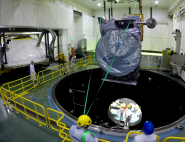MAJIS « Moon And Jupiter Imaging Spectrometer »
The MAJIS instrument is the JUICE mission’s infrared imaging spectrometer. Its main science goals are to study:
- The composition and physical properties of the surfaces of Ganymede, Europa and Callisto (ice, salts, minerals and organic compounds)
- The composition, structure and spatial and temporal variability of the exospheres of Ganymede, Europa and Callisto, and the relationship between the exosphere, surface and external sources
- The composition, structure, dynamics and evolution of the atmosphere of Jupiter from the troposphere to the stratosphere
- The composition and physical properties of Io, small moons, rings and dust in the Jovian system
The MAJIS instrument comprises three separate subsystems:
- The Optical Head (OH), which comprises the telescope, the VIS-NIR and IR spectrometers (0.5-5.54 µm), the FPA detectors and their FPE proximity electronics for each channel (built by U.S. firm Teledyne and procured by CNES), and the auxiliary scanner, calibration and shutter systems; construction of this subassembly is being overseen by the Italian space agency ASI.
- The Main Electronics unit (ME), which controls the two FPE+FPA VIS-NIR and IR detectors, delivers power, controls the instrument (board supplied by Italy), performs data processing and provides the spacecraft link.
- The Harness, which connects the OH on the JUICE optical bench with the ME integrated in the Vault, and ensures power distribution, science data collection, housekeeping and provides the SpaceWire communications link.
France is supplying the complete MAJIS instrument developed under the technical oversight of the IAS space astrophysics laboratory (PI: F. Poulet), with a contribution from the LESIA space and astrophysics instrumentation research laboratory—geometry data added to the mission ground segment pipeline—and the Optical Head (OH) supplied by the IAPS astrophysics and planetology institute, Italy. Radiation testing is under the responsibility of Belgium.



